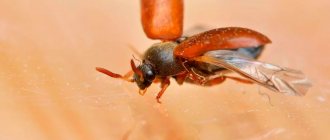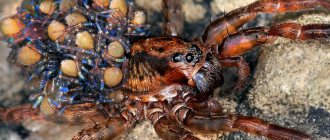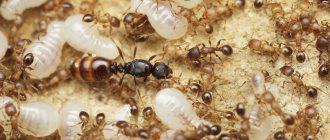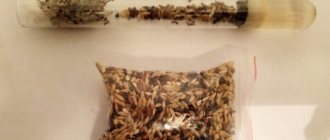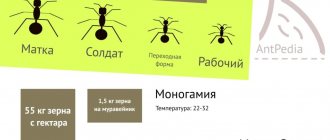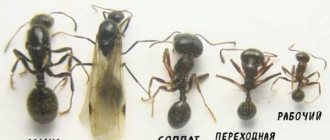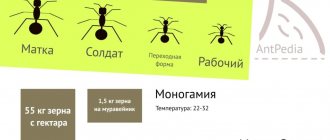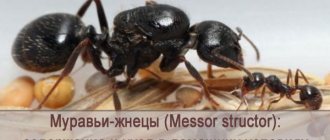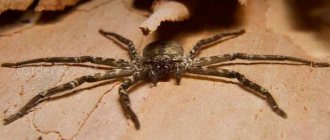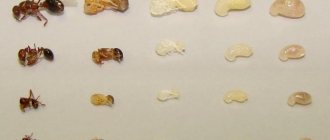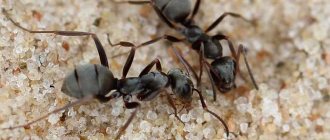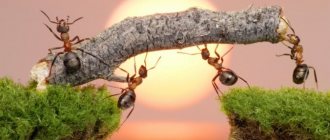In terms of the degree of coherence, they occupy a leading place among insects living in groups. Their states are a single organism. In the colonies of ants, which are among the oldest inhabitants of our planet, all social roles are clearly distributed: there is a queen queen who lays eggs, there are her guards who ensure the safety of their queen, there are soldiers who are ready to die for society, there are workers who work without straightening up. backs, there are breadwinners who provide food for society.
According to ant collectors, you can watch the life of the ant state for hours. It calms, relaxes, distracts from problems. The trend has been going on for more than a decade: people are buying colonies of ants and keeping them as pets. Ant fans communicate with each other on various Internet platforms, in special chats. And on YouTube there is even a special channel where you can get information about the rules for keeping these insects. Exotic species of ants are especially popular. But isn't this dangerous? And how can it affect the environment?
An unusual hobby of a future biologist
Creating a colony of ants at home is quite simple. In one of the many online stores, you order one or more queen ants, along with workers and larvae. Buying Central European ants will cost only a few euros, but prices for exotic species can amount to several tens of euros or more. The ants will be sent by mail in a test tube. After receiving the parcel, they are placed in a formicarium - a special sealed terrarium with soil or sand for keeping ants. And then through the glass they watch how insects build tunnels, create nests, transport food, and dispose of waste.
Benedict Rastetter
“Watching ants is very interesting. For me it’s a kind of meditation,” Benedict Rastetter, a student at the Faculty of Biology and Environmental Protection at the University of Greifswald and a big fan of ants, admits in an interview with DW. He has been studying them since childhood - formicariums with these insects occupy almost an entire room in his home. According to Benedict, most people have no idea how exciting his hobby is.
“You just have to try it to understand it. However, I under no circumstances advise beginners to purchase exotic species of ants. Special conditions must be created for them so that they can survive the winter here. In addition, if exotics somehow get out of the formicarium and begin to reproduce in nature in Europe, this is fraught with disruption of our ecosystem,” warns the future biologist and ecologist.
Leafcutter ants
Of all the ant species, Benedict is especially interested in the leafcutter ants, which are common in America. “They have the most complex social system. Their colonies work like clockwork. A special caste of these insects chews the leaves into a pulp. Ants flavor it with enzyme-containing saliva. Based on this mass, which releases moisture and heat, ants in greenhouse conditions grow mushrooms in their underground plantations - practically their only food. This is an amazing example of symbiosis,” says the student.
Ants as pets: they can teach a person a lot
On a carpet of ants
Student Mark Razumov has been studying ants for the 6th year. He says that this hobby is perfect for people with a contemplative mindset and an interest in the structure of society.
Mark, like many others, had a bad experience with breeding ants as a child, when his grandmother, at seven years old, brought him, in a three-liter jar, the neatly cut top of a forest anthill. The goosebumps, despite the efforts of their owner, soon one after another went to another world. After crying, Mark decided that when he grows up, he will first study from here to now what types there are and how to keep them, and only after that he will bring them to his house. That's what I did. A few years later, after extensive “walking” in circles of theoretical knowledge and specialized forums, the young man began breeding first harvester ants, and then black garden ants.
Now he has about 10 thousand ants of 12 species at home, including such a rare species as Camponotus fellah (carpenter ants). 2 years ago Mark ordered them from Israel. A colony of 50 ants and a queen (the standard version for sale) went to him in a large test tube, sealed with cotton wool... in a regular parcel, albeit first class. All the ants survived the two weeks of travel in good health. They also liked it in their new homeland, and now the number of this family has exceeded 500. Periodically, pets from one formicaria (artificial anthill) or from another run away to explore the space, gnawing through the mesh that separates them from the outside world.
“Once I came, and in my room there was a living “palace” on the floor of one and a half (as I later counted) thousand ants. The “return” operation took me more than five hours,” Mark laughs, recalling that incident.
Worldkeeper Mark Razumov. Photo from personal archive.
Deadly shooting in the series
System administrator Nikolai Yudin is a myrmikiper (ant breeder) with five years of experience. An unusual animal hobby literally fell on his head on one of the Moscow streets during the ant summer. Nikolai, who was also keenly interested in these insects in childhood, did not throw the queen of the black garden ant that had planned for him, but clutched it in his fist, deciding to use the chance that had been given to him. The ancestor of his first domestic colony was missing one limb, and she received the appropriate name - Lamefoot. A month later, in the incubator, from a 20-mm syringe (a common type of “room” for colonies beginning to form), the first generation of ants appeared, then the second, third... About a year later, Nikolai sent Lamefoot and her already numerous offspring to the biology classroom of one of the schools . Today, my interlocutor has experience in breeding completely different species, including very large ants - Asian Camponotus singularis. Their queen reaches a length of 2.5 cm, soldiers - 15–20 millimeters.
By the way, one of Yudin’s colonies fell victim to the servants of art. Filmmakers contacted Myrmikeeper via an online forum and asked him to rent out the ants as “props” for some domestic TV series. Handing over a 20-liter farm with harvester ants to the producer, the breeder clearly instructed how to care for the insects, but when a month later he got to the filming pavilion, he found next to the anthill only a mountain of twisted corpses mixed with pieces of kebabs, rolls and Snickers. All this time, the film workers stubbornly tried to feed the insects with human treats. But what is good for a man is death for an ant.
Ant breeder Nikolai Yudin. Photo from personal archive.
Human doubles
Ants are socially advanced insects. Therefore, observing their colonies is both interesting and instructive.
In the ant world there are agrarian-oriented states, where 80% of the population are harvester ants, engaged in collecting and storing seeds from cereals; there are, on the contrary, warring tribes, hunters for territories and slaves. The creative class of ants can conventionally be called scouts. At the same time, democratic systems can be established in some ant families, while totalitarianism and tyranny reign in others. Everything is very variable.
According to entomologist, Doctor of Biological Sciences, leading researcher at the Institute of Economics and Economics of the Russian Academy of Sciences Anatoly Zakharov, ants are biopolitical doubles of humans. Among the adult individuals in the anthill there is a deep differentiation (separation) of functions. Insects, if we use the concepts familiar to us, have many professions: farmers, builders who construct homes, roads, tunnels, hunters, coordinators, orderlies, cleaners, scouts, nannies, watchmen, observers, grooms (lickers) who clean other ants, honeydew collectors (that is, those who breed aphids and collect the sweet liquid they secrete - honeydew). Insect society is similar to human society, to the point that noble individuals - queen ants - have their own retinue. At the same time, they have a common brood, common food supplies and one roof over their heads for all. During its life, an ant can try several social roles - being a nanny, a builder, a soldier, a scout, a forager, settling on what he likes most. The final choice is influenced by psychological predisposition: bold individuals are more likely to become hunters, while calmer and phlegmatic individuals are more likely to become honeydew collectors, for example. And someone will live their whole life as a dependent and a drone, lazily watching their fellow tribesmen heroically at work.
Ants even fight just like humans! It becomes crowded in one territory - a conflict begins. Only we are trying to explain battles for resources with ideology, religion, geopolitics. By the way, ant wars can be very brutal, when hundreds of thousands, or even millions of ants can die in a few hours. But at the same time, there is always an alternative scenario, which is realized if the ants have some time to think after the first collision. In this case, they choose to unite instead of fight, starting an intensive barter trade with everything they can: pupae, larvae, females, worker ants, nesting material. As a result, in place of individual nests, a federation emerges with a common territory, a common strategy, and a common smell.
The colony is self-sufficient
Caring for ants does not involve any particular difficulties, especially if you choose domestic species such as red, garden or forest (exotic species can be demanding in terms of humidity and nutrition). The most unassuming species and quite large (and the larger the ant, the easier it is to observe its life), which is usually recommended for beginners, are harvester ants. Experienced breeders do not shy away from breeding them for fun. For example, at Nikolai Yudin’s home there is now a colony of reapers of five thousand individuals living in a 75-liter anthill made of gypsum.
Ants are very neat creatures and store all their garbage in one corner. They also take their deceased comrades there. So they will do the general cleaning themselves, and you will only have to clean one single corner.
Medium-sized colonies will not give you any trouble in terms of food. “For some species, the basis of the diet is syrup from water with sugar and grain, for others, predatory ones, meat in the form of marbled cockroaches and mealworms, crickets and fruit flies,” says Mark Razumov. However, giant colonies can be very voracious. One of the breeders in a house near Moscow raised up to a million forest ants, equipping them with a 12-square-meter room for apartments. In addition to various syrups, which had to be diluted in liters, this brotherhood ate a kilogram or two of meat every day. And then the thrifty man figured out how to avoid spending: he took a pipe out of the room where the ants were kept and into the nearest forest; fortunately, his country estate was located on the edge of the garden community. And the ants, driven to self-satisfaction, began to go “to the ground” every day and get their own food.
By the way, ants have excellent memory. “When an ant enters an area in the spring, it remembers the road along which it last walked in the fall; he remembers the places where there were outposts, feeding nests, forks, and is able to recognize up to 40–50 of his comrades “by sight,” says Anatoly Zakharov. “A tactile code, or, in other words, the language of antennae helps ants communicate. They tap their antennas on each other, transmitting information, and very meaningful ones at that. They can point out exactly where to go.”
If you suddenly decide to join the myrmikeepers, then you can either wait until summer to catch the queen ant during the traditional ant summer, or buy a small colony of ants. It will cost approximately from 300 to 1200 rubles. Moreover, on the forums you can always find breeders who place their ants in good hands for free. True, all of these will be domestic bottlings. Species atypical for Russia, such as leaf cutters, can cost up to $1,000 for a “queen” with a small retinue. A gypsum ant farm will cost you 500–1000 rubles.
BY THE WAY
Ants are one of the most common insects on the planet. Today there are about 12 thousand different species. The weight of an ant can vary (depending on the species) from 1 to 1500 milligrams, length from 1 to 45 millimeters.
In nature, the queen ant lives 20–25 years, and the worker ant lives up to 4–7 years. The colonists do not harm injured or injured individuals who have lost the ability to walk long distances and continue to feed them. And the ant itself can change its profession. For example, become a nanny or do grooming.
Dear readers!
Send your questions and suggestions to [email protected]
The man who makes money from ants
“The King of the Ants” is how Berlin-based entrepreneur Martin Sebesta is often called. And not without reason: the company he created more than 20 years ago called Antstore (“Anthill”) specializes in the sale of ant colonies. This is the first and only large enterprise of its kind in Germany. The total area of its premises is 1000 square meters. There are more than 20 employees on staff: anthill care specialists, glaziers and plastics technology specialists, salespeople, logisticians, developers, as well as management personnel.
Martin Sebesta
“We notice that the demand for ants is constantly increasing. I usually have 20-30 thousand ant colonies. True, there are fewer of them now, since due to the pandemic it is impossible to travel to buy them,” Martin Sebesta tells DW. Colonies, according to him, are very different: “There are very small ones - from several insects that fit in the acorn. And there are large ones that make nests with an area of 50 square meters and eight meters deep - in fact, this is an entire apartment.”
Martin began to be interested in ants at the age of five: he really loved watching them in the garden. “I was curious about how their life works underground, where their nest is located. And later I made a home for the ants in an old aquarium. I constantly followed them, took photographs, made notes, and in the late 1990s I began to post these materials on a specially created website on the Internet,” he recalls. It turned out that there are many people interested in the life of ants. “They left their reviews on my website, sent me messages, shared their experiences. And over time, I realized that I wanted to make this hobby my life’s work,” says the entrepreneur, who has found his niche in the market.
According to him, he quickly established the necessary contacts with people who specialized in breeding ants. I also traveled a lot around the world, visited Latin America, Africa, Asia, Australia - and on the spot communicated with those who are interested in collecting ants. Now he has a wide network of contacts.
Reaper Ants
Farms are different. Some breed breeding bulls, others breed harvester ants.
What kind of pets do Ussuriians have? Photo: provided by the breeder
Igor purchased an ant farm a year ago in Vladivostok. I didn’t find it in Ussuriysk, because it turned out that domesticated ants are too exotic for local residents. Although, it would seem, the ants are unpretentious guys, they build anthills, carry logs 100,500 times heavier than their weight, and teach dragonflies that have sung through the summer.
What kind of pets do Ussuriians have? Photo: provided by the breeder
But as it turned out, harvester ants are more capricious than their forest counterparts. Firstly, they live in special flasks, where there should be no bright light, temperature changes or any stress. Due to stress, the queen ant flatly refuses to lay eggs, which directly affects the demographic policy of the ant kingdom. By the way, the queen ant is very prolific, giving birth to 20-30 babies at a time, which after a couple of stages turn into transparent ants. After a week, the invisible ants take on their normal appearance.
What kind of pets do Ussuriians have? Photo: provided by the breeder
What kind of pets do Ussuriians have? Photo: provided by the breeder
1
/ 2
Secondly, reapers drink heavily. Not like the average Russian on New Year's holidays, but also important - a regular water supply must be set up in the house. For example, a damp sponge.
Thirdly, reapers have their own diet. They especially prefer poppy seeds, food for small canaries, parrots, and fish (small dried crustaceans). But in particular honor are egg whites and boiled chicken breast.
Despite their free lifestyle, harvester ants periodically escape from their farms. Igor told how every now and then he came across ants that had somehow escaped from a tightly sealed container.
In conditions close to natural
A very important criterion for the work of his company, Sebesta emphasizes, is to create conditions for ants in which they have enough space to move and develop a colony - after all, the life expectancy of some species of these insects can be up to three, four or more decades. “We are constantly improving when it comes to keeping ants. Currently, we use spacious formicariums where ant colonies can be maintained for years and even decades,” he notes.
Watching ants through the glass of the formicarium is very exciting, fans of this hobby assure
According to the businessman, his clients include people of all age groups - from children to pensioners. Ant colonies are also purchased by various companies, natural history museums, artists for certain art projects, film and television studios, medical practices, law offices, zoos, universities, and schools.
“People are interested in observing how ants live, how everything is organized, and what strategies they use. Here, for example. The diameter of the hole through which the ants enter their nest is about 5 millimeters. But as a group of ants approach him, transporting the large beetle they found, the hole expands to 13 millimeters. That is, they somehow inform their brothers that they have large prey. But how? The answer to this question has not yet been found,” Martin Sebesta shrugs.
Wintering of insects
Ants “starve” for a long time only during the wintering period, and then only if they hibernate. Many representatives of these insects clog up their homes during cold weather and continue to stay awake, feeding on the supplies they collected earlier.
Harvester ants, whose diet consists of 97% seeds of various plants, collect up to a kilogram of these products during the warm season and quietly feed on this all winter. During cold weather there are no larvae, so protein foods are not needed.
Ants hibernate at low temperatures (below -10 °C) and awaken when it gets warmer, so they endure the winter absolutely calmly.
Ants that live in human houses do not even prepare for winter: there is always food, the temperature is normal.
Scientists' warning
Recently, scientists from the University of Lausanne decided to establish what types of ants are offered on the Internet. Invasive species were found to be disproportionately traded. If this continues, they will spread throughout the world, and this is a serious threat to the environment, experts warn. According to Martin Sebest, his company has nothing to do with this.
“We do not acquire invasive ant species. There are people who bring them back from vacation and then exchange them with other hobbyists. There are even special groups on Facebook where ant fans gather. But we never sell dangerous species of ants,” the entrepreneur emphasizes.
See also:
Dangerous animals in Germany
Traveling ants
Stray ants Ecitons do not have their own home and are constantly on the move. They carry their entire complex ant economy with them. Most Etsitons are ruthless and ferocious soldiers. They are located at the edges of the column, providing its protection. Worker ants carry larvae on their bodies when they travel. They and the uterus move in the center. For about 20 days, the colony of ecitons moves non-stop, at high speed, hunting and feeding as they go.
Long roads of Etsitons
There are no obstacles for such a multimillion-strong army, and it acts like one flawlessly tuned machine. To cross rivers, ants build “bridges” and “ladders” from their own bodies. On the way, they eat everything they find: all kinds of insects, mice, helpless chicks. In Argentina, people even leave villages for a while, seeing that the path of the Ezitons will pass through them, because it is impossible to turn around or stop the column.
Fire salamander
The fire salamander (lat. Salamandra salamandra) is one of the most common and prominent representatives of the salamander genus. The tailed amphibian, reaching 23 cm in length, prefers a cool, moist environment. The amphibian's venom is not dangerous for humans, but even a light touch to it causes a burning sensation - the salamander's coloring warns of toxicity.
Dangerous animals in Germany
Enemies and protection of ants
Ants have many enemies. Some of them penetrate inside the anthill, stealing supplies and eating the offspring. In addition to internal enemies, ants have many external ones. Thus, brown bears love to feast on these insects. Birds, wasps and predatory flies also feed on ants; lizards, moles and toads eat them. And in the tropics, anteaters feed on ants.
Giant anteater native to South America
The giant anteater is a large animal: its length including its tail reaches 230 cm. An elongated muzzle and a long, 60-centimeter tongue help it in hunting. When an anteater sticks its nose into an anthill, it begins to quickly work with its tongue: in one minute, the tongue protrudes and retracts 160 times. And since the anteater's saliva is sticky, ants stick to it - so it can eat about 30,000 insects per day.
Another enemy of ants is the antlion. This beautiful insect, similar to a dragonfly, feeds on pollen, and the enemy of ants is its larva. She makes a funnel out of tiny grains of sand, and she hides in its neck. An ant that lands on the slope of a funnel inevitably rolls straight into the lion's mouth.
Predatory antlion larva
Antlion trap in sand
However, ants do not always give themselves offense. They know how to defend themselves using poison - formic acid. With their jaws they can even bite through the skin of a person or large animal. Ants also know how to pretend to be dead in case of danger. But the main defense of ants is their number. Even after a fire, several ants remain alive.
Self-test questions
- Why are ants harmful?
- How are ants useful?
- Which animal is a “cow” for ants?
- Why was an insect similar to a dragonfly called an antlion?
Mite
Among the huge number of species of ixodid ticks (lat. Ixodida), living in forests, parks and even in vegetable gardens in Germany, there are carriers of dangerous diseases - tick-borne encephalitis and tick-borne borreliosis. Therefore, you should always be wary of the bite of these bloodsuckers measuring from 2.5 to 4 millimeters, because the consequences may be irreversible.
Dangerous animals in Germany
Ants as pets: a new trend is conquering the world
Instead of a cat or a dog - a colony of ants? Formicarium instead of an aquarium? The demand for ants, especially exotic ones, is growing around the world. What is the reason for the popularity of this unusual hobby? And isn't it dangerous for the environment?
In terms of the degree of coherence, they occupy a leading place among insects living in groups. Their states are a single organism. In the colonies of ants, which are among the oldest inhabitants of our planet, all social roles are clearly distributed: there is a queen queen who lays eggs, there are her guards who ensure the safety of their queen, there are soldiers who are ready to die for society, there are workers who work without straightening up. backs, there are breadwinners who provide food for society.
According to ant collectors, you can watch the life of the ant state for hours. It calms, relaxes, distracts from problems. The trend has been going on for more than a decade: people are buying colonies of ants and keeping them as pets. Ant fans communicate with each other on various Internet platforms, in special chats. And on YouTube there is even a special channel where you can get information about the rules for keeping these insects. Exotic species of ants are especially popular. But isn't this dangerous? And how can it affect the environment?
Sea Dragon
Those who like to swim in the waters of the North and Baltic Seas, washing the coastal zones of northern Germany, are in for some unpleasant surprises: sea dragons (Latin Trachinidae) love to burrow into the sand and sting swimmers who step on them. In this case, the victim may develop a fever and vomit... To neutralize the poison, you need to remove the sting and immerse your leg in hot water.
Dangerous animals in Germany
Viper
Only two species of venomous snakes are found in Germany. One of them is the common viper (lat. Vipera berus). The venom of this small (about 65 cm) snake is stronger than that of the American rattlesnake, but the European pit viper has much less of it - fortunately for those whom this timid snake does bite. The bite is painful and can cause vomiting and headaches, but it is not fatal.
Dangerous animals in Germany
Cross
Almost all spiders are poisonous. But the poison of most of them is not dangerous to humans. It is most powerful in the crossweed (lat. Araneus), whose venom contains hemotoxin. For humans, the amount of poison released by the cross is harmless, but the bite can be painful. This spider usually settles in the crowns of trees: in forests and gardens.
Dangerous animals in Germany
Cyanea
Hairy cyanea (lat. Cyanea capillata) is a real disaster for residents of the coastal regions of Germany and vacationers. The slightest touch to the fiery beauty in the water or on the shore responds with burning pain: this is the effect of the poison that is supplied to the stinging cells of the jellyfish’s tentacles. Painful shock can even cause cardiac arrest.
Dangerous animals in Germany
Som
The European catfish (Silurus glanis) feels great in Germany. Some individuals reach 150-190 cm in length. Such a catfish may well bite, especially if the swimmer accidentally steps on the nest or is near it. In small holes in shallow water, before spawning, females build nests, which the males then guard. A catfish bite is not dangerous to health.
Dangerous animals in Germany
How do ants' mouthparts work?
Ants have a gnawing type of mouthparts, which can be roughly divided into three parts: the upper and lower lips and jaws, with which the insect chews food. The jaws can be large and small, sharp and blunt, smooth and with teeth, overlapping or closing - it depends directly on the type of Hymenoptera. Ants have a small tongue on their lower lip, which is a taste organ.
Ants belong to the order Hymenoptera, although only males and females have the means to fly, and simple workers move exclusively with the help of their paws.
Wasp, hornet, bee...
If you have an allergy, the bite of nectar hunters can be fatal. But those who, for example, disturb a nest of wasps or hornets will not be in trouble. It's all about the number of bites, and therefore the dose of poison received. In the picture: the common hornet (lat. Vespa crabro). Despite its impressive size (up to 35 mm), the hornet is considered less aggressive than the wasp.
Dangerous animals in Germany
Who eats ants
The smaller the animal, the more enemies it has who want to kill and eat it. Ants are eaten by all and sundry:
- birds,
- frogs,
- rodents,
- bears - they destroy anthills and feast on insects,
- anteaters,
- splash fish,
- woodpecker - its plumage is covered with resin, which sticks to the prey.
Over many millennia of struggle with other creatures, ants have developed a poison that they “give” to their offenders, so not all animals attack the anthill: they prefer to feast on insects running past. But the bear is not afraid of poison, so he calmly destroys the ants’ house and rakes them with his paws.
The bites of some ants (for example, tropical ones) are very dangerous: some cases are fatal, especially if the person is allergic to insect saliva. Therefore, if there are ants on your territory, you need to learn how to provide first aid for their bite.
Ants quite effectively fight various small insect pests in the garden, but some of their species are themselves enemies of the crop. Sometimes people, without understanding, immediately destroy an anthill, and this is a big mistake: first you need to determine the type of insects (in case they are predators) and only after that decide what to do with them.
Boar, wild boar... game
Germany is a country of forests. It is clear that there is plenty of game in them. So, bad luck may come to those who “cross the path” of a wild boar or a wild pig with a litter. Such unwanted encounters are extremely rare - the wild boar usually avoids them himself. But if they happen, it is important not to touch or photograph the brood, avoid fussy movements and try to leave quietly.
Dangerous animals in Germany
We choose a pet - ants.
When people decide to have pets, they are sometimes faced with a difficult choice. Who should I choose? Cat, dog, rat, fish? Some people decide to get exotic pets. Such as a crocodile, a monkey or a python... But here I want to talk about small harmless insects - ants. It turns out there are many types of them and they are quite domestic. You can watch them and, as psychologists say, they relieve stress just as well as fish. Why ants as pets?
If you want to have unusual pets, ants are a great choice. These are very interesting creatures, a real pleasure to watch. In addition, the following facts speak in favor of ants:
— You don’t need a lot of space, which means you can have them even in a small city apartment;
— Not particularly picky about food;
— Ants do not have an unpleasant odor;
— They take care of their own waste, unlike the great many domestic animals that need to be cleaned up frequently;
— Not dangerous for you, your children, your guests;
— Quite tenacious and practically do not require medical care;
- If you provide them with food and water for a long period of time, you can leave them unattended for a long time;
— The lifespan of one worker reaches a couple of years (which is quite a long time for insects), and the entire colony can function for a very long time;
— A high-quality formicarium in which the ants will create their own tunnels (or you will make them yourself) looks great and will be the highlight of almost any interior;
— If you make a formicarium yourself and find (during the summer) a “ready” queen, then the costs of owning these pets are minimal. And then the main part of the expenses is related to their food, which, in principle, is not much. That is, ants are fairly inexpensive animals to keep;
However , you need to remember that ants are special pets and you need to think about everything before you get them. However, if you decide to get them, you probably won’t regret it.
In online stores that specialize in domestic ants, you can find everything you need. From the formicarium itself, food and all sorts of things to the pets themselves. You need to remember that ants taken from the street will die very quickly. So it’s best to write them out by mail, or buy them at the appropriate store, if you have one in your city.
In any case, if you decide to get yourself some pet ants and become a real keeper, then you need to be properly prepared. After all, your pets will need your care and love. However, like any other.
And here is a short 25-minute video from Wasilisc on the topic. Very interesting.
Source
